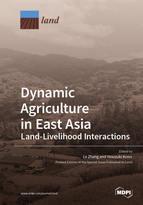Dynamic Agriculture in East Asia: Land-Livelihood Interactions
A special issue of Land (ISSN 2073-445X). This special issue belongs to the section "Land Socio-Economic and Political Issues".
Deadline for manuscript submissions: closed (31 December 2022) | Viewed by 28659
Special Issue Editors
Interests: agrarian change; rural livelihood transition; land use/land cover change
Special Issue Information
Dear Colleagues,
Agriculture is an essential industry that provides products (food, biofuel and fiber, etc.) for sustaining human life. Changes in agricultural systems have a profound impact on food security and environmental health. As one of the most densely populated regions in the world, East Asia has evolved into having a relatively stable mode of smallholder agriculture and homogeneous rural societies in the past forty centuries. However, subsistent smallholder agriculture has been abandoned due to the massive industrialization and urbanization in this region since the end of the 20th century.
A livelihood is a means of gaining a living and encompasses the capacity, assets, and activities required for achieving livelihood goals. The livelihood enterprises of rural households can generally be divided into agricultural production and off-farm employment, while farmers must carefully consider how to invest their resources in the two enterprises since they are extremely limited in time and capital. Thus, farmers’ attitudes and behaviors toward agricultural production essentially depend on their livelihood choices. As the carrier of agricultural production, the quantity and quality of land is another key factor that affects the form of agricultural systems; for example, large farms usually occur in plain areas, and banana cropping can only be grown in tropical regions. Therefore, the dynamic change in agricultural systems is essentially driven by rural livelihood transitions in the context of socioeconomic transformation, such as the reform of agricultural and land policy, and the process must be based on the state of land resources.
This Special Issue aims to clarify how the interactions of rural livelihoods and land create diverse and dynamic agricultural systems across the different socioeconomic and biophysical backgrounds in East Asia. We encourage authors to submit interdisciplinary manuscripts that are based on field surveys in a wide range of geographical contexts.
Prof. Dr. Le Zhang
Prof. Dr. Yasuyuki Kono
Guest Editors
Manuscript Submission Information
Manuscripts should be submitted online at www.mdpi.com by registering and logging in to this website. Once you are registered, click here to go to the submission form. Manuscripts can be submitted until the deadline. All submissions that pass pre-check are peer-reviewed. Accepted papers will be published continuously in the journal (as soon as accepted) and will be listed together on the special issue website. Research articles, review articles as well as short communications are invited. For planned papers, a title and short abstract (about 100 words) can be sent to the Editorial Office for announcement on this website.
Submitted manuscripts should not have been published previously, nor be under consideration for publication elsewhere (except conference proceedings papers). All manuscripts are thoroughly refereed through a single-blind peer-review process. A guide for authors and other relevant information for submission of manuscripts is available on the Instructions for Authors page. Land is an international peer-reviewed open access monthly journal published by MDPI.
Please visit the Instructions for Authors page before submitting a manuscript. The Article Processing Charge (APC) for publication in this open access journal is 2600 CHF (Swiss Francs). Submitted papers should be well formatted and use good English. Authors may use MDPI's English editing service prior to publication or during author revisions.
Keywords
- agrarian change
- new agriculture
- food security
- land resource
- rural livelihood
- land use/land cover







